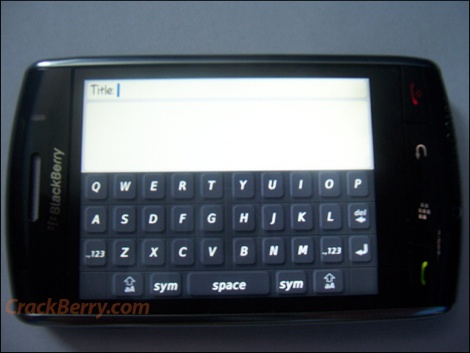Quite a few new handsets are offering tactile feedback on their touchscreens, like the Blackberry Thunder, pictured above. I can’t help thinking that because the manufacturers can’t do multitouch properly, they are opting to enrich their feature lists in other ways.
Is it really a valuable feature? In concept, tactile feedback is wonderful. It is the reason that real keyboards are way easier to use than on a touchscreen. However, the execution is quite different. Consider the micro-interaction of pushing your finger down on a key on a real keyboard or keypad:
- You line your finger up as best you can
- The tactile landscape of the device tells you whether you have lined up your finger properly or if you are overlapping with other keys
- As your finger presses down, you get a satisfying ‘click’, letting you know that it worked.
In other words, you get tactile feedback before the act as well as after the act. Most important is the feedback beforehand, since it allows you to adjust your action accordingly. The reason why all these new handsets are missing the point is that they only give after the act feedback. It’s a vague confirmation. Essentially it’s saying “Yeah, you pressed a key. You wont know which one, though, until you look at the screen.”
So, what should they be doing instead? Concentrating on honing the primary features. Adding enhancements that offer deep, lasting value rather than just an additional bullet point on the promotional materials.

It’s pretty much pointless to have beforehand signal on such a small device because the users typically have to look at the buttons when using. Just like typing, we typically know when we made a mistake before looking at the screen. Speed and fat fingers are the culprits here, not pre-clicking inputs.
Hi Rob, thanks for taking the time to write a comment!
I hope you don’t mind if I disagree with your point. If you look at the tactile detail on a typical handset, you’ll see the keypad is covered with a rich tactile landscape. You can feel your way to each key by the nubs, grooves and distances from the edge of the device. It’s almost like Braille – to a familiar user entering a word is almost a sightless task. This is what I mean by “before-the-act†tactile feedback.
A rich, well designed tactile landscape makes it far easier to enter data, making life easier for people with fat fingers and fast typists. A touch screen, on the other hand, is barren and featureless. It makes sense to attempt to enhance it with artificial tactile feedback, but we’re a long way from achieving an equivalent experience.
Actually there are some better haptic technologies that can help you feel buttons before you press them. You’re right, though, that some of the early haptics are not that great and can also be irritating.
There was a CHI 2008 paper by Eve Hoggan and others that found that there is indeed a benefit to haptic feedback for typing, and the higher fidelity the haptics, the better the results.
Apple took a different direction with the iPhone keyboard by building in features like predictive text and dynamically changing the active area of keys. Adding haptics to the iPhone would be tricky because you’d probably defeat these other tricks.
Hi Kevin
Thanks for the pointer to the Hogan et al paper. Looks interesting. Unfortunately my ACM account has expired, so I’m left unable to question their methodology and experimental set up. Then again, it is a CHI paper so it’s probably quite short with just a couple of tiny photos. You gotta love the CHI review process :-)
Great post! To add to the bit about the iPhone, I really to like the approach that apple has taken by enhancing their error correcting technology. The combination of speed (from not having to actually press a button, but simply touch it) combined with dynamically resizing keys allows for a much better, and faster typing experience – it’s is the best that I have used. I never would have typed this comment on a phone in the past, but here I am. Also, I don’t know of other iPhone owners can do this, but I have found that I can pretty accurately type without even looking at the keys. No haptic or even visual feedback needed. The mistakes that I do make are almost always corrected.
Almost always :)
I have to completely disagree with Kris about the iPhone.
The iPhone’s smart keyboard forces you to make mistakes, even when you’re an expert and have 100% accuracy. It actually punishes the experty user.
It’s impossible to type “Hanford” on the iphone without using the delete key. It drives me crazy, esp. since I’m pretty accurate with the keyboard now and wouldn’t need to hit delete if it weren’t for the “Smart” logic.
More on it here:
http://blog.hanfordlemoore.com/2008/09/16/iphone-why-wont-you-let-me-type-my-name